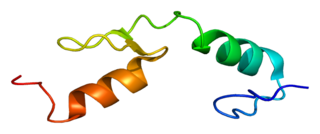
Zinc finger transcription factor Trps1 is a protein that in humans is encoded by the TRPS1 gene.

Cone-rod homeobox protein is a protein that in humans is encoded by the CRX gene.

Zinc finger protein 148 is a protein that in humans is encoded by the ZNF148 gene.

Transcriptional regulator Kaiso is a protein that in humans is encoded by the ZBTB33 gene. This gene encodes a transcriptional regulator with bimodal DNA-binding specificity, which binds to methylated CGCG and also to the non-methylated consensus KAISO-binding site TCCTGCNA. The protein contains an N-terminal POZ/BTB domain and 3 C-terminal zinc finger motifs. It recruits the N-CoR repressor complex to promote histone deacetylation and the formation of repressive chromatin structures in target gene promoters. It may contribute to the repression of target genes of the Wnt signaling pathway, and may also activate transcription of a subset of target genes by the recruitment of catenin delta-2 (CTNND2). Its interaction with catenin delta-1 (CTNND1) inhibits binding to both methylated and non-methylated DNA. It also interacts directly with the nuclear import receptor Importin-α2, which may mediate nuclear import of this protein. Alternatively spliced transcript variants encoding the same protein have been identified.

Neural retina-specific leucine zipper protein is a protein that in humans is encoded by the NRL gene.

Transcription factor Sp4 is a protein that in humans is encoded by the SP4 gene.

Zinc finger protein Aiolos also known as Ikaros family zinc finger protein 3 is a protein that in humans is encoded by the IKZF3 gene.

Zinc finger protein 40 is a protein that in humans is encoded by the HIVEP1 gene.

Zinc finger and BTB domain-containing protein 7A is a protein that in humans is encoded by the ZBTB7A gene.

Myelin transcription factor 1 is a protein that in humans is encoded by the MYT1 gene.

POZ-, AT hook-, and zinc finger-containing protein 1 is a protein that in humans is encoded by the PATZ1 gene.

ZIC1 is a member of the Zinc finger of the cerebellum (ZIC) protein family.

Zinc finger protein 143 is a protein that in humans is encoded by the ZNF143 gene.

Insulinoma-associated protein 1 is a protein that in humans is encoded by the INSM1 gene.

Transcription factor HIVEP3 is a protein that in humans is encoded by the HIVEP3 gene.

Zinc finger protein 239 is a protein that in humans is encoded by the ZNF239 gene.

Early growth response protein 4 (EGR-4), also known as AT133, is a protein that in humans is encoded by the EGR4 gene.

Zinc finger protein 266 is a protein that in humans is encoded by the ZNF266 gene.

Zinc finger protein 398 is a protein that in humans is encoded by the ZNF398 gene.

Zinc finger protein 444 is a protein that in humans is encoded by the ZNF444 gene.




















